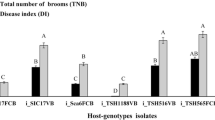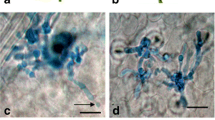Abstract
Eighteen barley isolates of Bipolaris sorokiniana belonging to wild and clonal type of black, mixed and white subpopulations were quantitatively assayed for their melanin content and aggressiveness with respect to production of some of the extracellular enzymes such as cellulase, pectinase, amylase and protease. Cellulase and pectinase constituted major portion of the enzymes recovered from the black, mixed and white isolates. Enzyme production and aggressiveness were relatively higher in melanin devoid or low melanin isolates. The melanin deficient isolates were also differentiated from black and mixed isolates on the basis of variation in internal transcribed spacer region of the ribosomal DNA. Higher enzyme productions positively correlated with area under disease progress curve (AUDPC) and lesion development. Melanin content was negatively correlated with extracellular enzymes and aggressiveness of the isolates. Based on melanin content, lesion size, AUDPC and extracellular enzymes, the isolates were grouped in two major clusters (I and II) with further division of cluster II into two sub-clusters (II-A and II-B). The results appears to indicate a possible role of melanin in release of extracellular enzymes and hence in evolution and selection of aggressive isolates of B. sorokiniana in barley.



Similar content being viewed by others
References
Apoga D, Akesson H, Janson HB, Odham G (2002) Relationship between production of the phytotoxin prehelminthosporol and virulence in isolates of the plant pathogenic fungus Bipolaris sorokiniana. Eur J Plant Pathol 108:519–526
Bakri Y, Jawhar M, Arabi MI (2008) Polymorphism in the ITS region of Ribosomal DNA of Cochliobolus sativus Isolates Differing in Xylanase Production. Polish J Microbiol 57:77–79
Barnett EA, Fergus CL (1971) The relation of extracellular amylase, mycelium and time in some thermophilic and mesophilic Humicola species. Mycopatho MycoI Appl 44:131–141
Bashyal BM, Chand R, Kushwaha C, Sen D, Prasad LC, Joshi AK (2010) Association of melanin content with conidiogenesis in Bipolaris sorokiniana of barley (Hordeum vulgare L.). World J Microbiol Biotechnol 26:309–316
Bell AA, Wheeler MH (1986) Biosynthesis and functions of fungal melanins. Annu Rev Phytopathol 24:411–451
Carzaniga R, Fiocco D, Bowyer P, Connell RJ (2002) Localization of melanin in conidia of Alternaria alternata using phage display antibodies. Mol Plant Microbe Interact 15:216–224
Chand R, Yadav OP, Bashyal BM, Prasad LC, Joshi AK (2012) Technique for the maintenance of heterokayotic isolates of Bipolaris sorokiniana under ordinary conditions. Indian Phytopath 65:2–6
Chand R, Sen D, Prasad KD, Singh AK, Bashyal M, Prasad LD, Joshi AK (2008) Screening for disease resistance in barley cultivars against Bipolaris sorokiniana using callus culture method. Indian J Exp Biol 36:249–253
Chaurasia S, Chand R, Joshi AK (2000) Relative dominance of Alternaria triticina Pras. & Prab. and Bipolaris sorokiniana (Sacc.) Shoemaker in different growth stages of wheat (T. aestivum L.). J Pl Dis Protec 107:176–181
Chaurasia S, Chand R, Joshi AK (1998) A simple technique for the induction of sporulation in Alternaria triticina incitant of leaf blight of wheat. J Pl Dis Protec 105:17–21
Clark RV (1979) Yield losses in barley cultivars caused by spot blotch. Can J Pl Pathol 1:113
Christian L (2012) Variation and Selection of Quantitative Traits in Plant Pathogens. Ann. Rev Phytopathol 50:319–338
Fu-Ming Dai, Xu Tong, Wolf GA, He ZH (2006) Physiological and Molecular Features of the Pathosystem Arabidopsis thaliana L.-Sclerotinia sclerotiorum Libert. J Integrat Pl Biol 48:44–52
Dubey R, Adhikary S, Kumar J, Sinha N (2010) Isolation, production, purification, assay and characterization of alkaline protease enzyme from Aspergillus niger and its compatibility with commercial detergents. Dev Microbiol Mol Biol 1:75–94
Duveiller E, Kandel YR, Sharma RC, Shrestha SM (2005) Epidemiology of foliar blights (spot blotch and tan spot) of wheat in the plains bordering the Himalayas. Phytopathol 95:248–256
Eliahu N, Igbaria A, Rose MS, Horwitz BA, Lev S (2007) Melanin biosynthesis in the maize pathogen Cochliobolus heterostrophus depends on two mitogen activated protein kinases, Chk1 and Mps1, and the transcription factor Cmr1. Eukaryot Cell 6:421–429
Ernandes Joel de Moura Nascimento, Sueli Teresinha Van Der Sand (2008) Restriction analysis of the amplified ribosomal DNA spacers ITS1 and ITS2 of Bipolaris sorokiniana isolates. World J Microbiol Biotechnol 24:647–652
Frederick BA, Caesar-TonThat TC, Wheeler M, Sheehan KB, Edens WA, Henson JM (1999) Isolation and characterization of Gaeumannomyces graminis melanin mutants. Mycol Res 103:99–110
Gadd GM (1982) Effects of media composition and light on colony differentiation and melanin synthesis in Microdochium bolleyi. Trans Br Mycolo Soc 78:115–122
Garcia Vallve S, Palau J, Romeu A (1999) Horizontal gene transfer in glycosyl hydrolases inferred from codon usage in Escherichia coli and Bacillus subtilis. Mol Biol Evol 9:1125–1134
Goldberg I (1994) Functional foods. Chapman and Hall, New York
Goossen J, Röper H (1994) Erythritol; a new sweetener. Confect Prod 24:182–188
Kawamura C, Tsujimoto T, Tsuge T (1999) Targeted disruption of a melanin biosynthesis gene affects conidial development and UV tolerance in the Japanese pear pathotype of Alternaria alternata. Mol Pl Micro Interact 12:59–63
Henson JM, Butler MJ, Day AW (1999) The dark side of the mycelium: melanins of phytopathogenic fungi. Ann Rev Phytopathol 37:447–471
Joshi AK, Ortiz-Ferrara G, Crossa J, Singh G, Sharma RC, Chand R, Parsad R (2007) Combining superior agronomic performance and terminal heat tolerance with resistance to spot blotch (Bipolaris sorokiniana) of wheat in the warm humid Gangetic Plains of South Asia. Field Crops Res 103:53–61
Kawamura C, Moriwaki J, Kimura N, Fujita Y, Fuji S, Hirano T, Koizumi S, Tsuge T (1997) The melanin biosynthesis genes of Alternaria alternata can restore pathogenicity of the melanin-deficient mutants of Magnaporthe grisea. Mol Plant Microbe Interact 10:446–453
Kumar D, Chand R, Prasad LC, Joshi AK (2007) A new technique for monoconidial culture of the most aggressive isolate in a given population of Bipolaris sorokiniana, cause of foliar spot blotch in wheat and barley. World J Microbiol Biotechnol 23:1647–1651
Kumar J, Hückelhoven R, Beckhove U, Nagarajan S, Kogel KH (2001) A compromised Mlo pathway affects the response of barley to the necrotrophic fungus Bipolaris sorokiniana (teleomorph: Cochliobolus sativus) and its toxins. Phytopathol 91:127–133
Kumar J, Schäfer P, Hückelhoven, Langen G, Baltruschat H, Stein E, Nagarajen S, Kogel KH (2002) Bipolaris sorokiniana, a cereal pathogen of global concern: cytological and molecular approaches towards better control. Mol Plant Pathol 3:185–195
Kumar S, Tamura K, Nei M (1994) MEGA: Molecular evolutionary genetics analysis software for microcomputers. Comput Appl Biosci 10:189–191
Langfelder K, Streibel M, Jahn B, Haase G, Brakhage AA (2003) Biosynthesis of fungal melanin’s and their importance for human pathogenic fungi. Fungal Genet Biol 38:143–158
Lowry OH, Rosebrough NJ, Farr AL, Randall RJ (1951) Protein measurement with the Folin phenol reagent. J Biol Chem 193:265–275
Maeda K, Fukuda M (1996) Arbutin: mechanism of its depigmenting action in human melanocyte culture. J Pharm Exp Ther 276:765–769
Maraite H, Di Zinno T, Longree V. Daumerie, Duveiller E (1998) Fungi associated with foliar blight of wheat in warm areas. In: Duveiller E, Dubin HJ, Reeves, McNab A. (eds.), Helminthosporium Blights of Wheat: Spot Blotch and Tan Spot. Proceedings of the International Workshop on Helminthosporium Diseases of Wheat: Spot Blotch and Tan Spot, El Batán, Feb 9-14, 1997. Mexico D.F.: CIMMYT. pp. 293–300
Miller GL (1959) Use of dinitrosalicylic acid reagent for determination of reducing sugar. Ana Chem 31:426–428
Murray MG, Thompson WF (1980) Rapid isolation of high molecular weight plant DNA. Nucleic Acids Res 8:4321–4326
Pandey SP, Kumar S, Kumar U, Chand R, Joshi AK (2005) Source of inoculation of spot blotch pathogen and the variation in the pathogen population at interaspecific level. Euro J Pl Pathol 111:47–55
Pandey SP, Sharma S, Chand R, Shahi P, Joshi AK (2008) Clonal variability and its relevance in generation of new pathotypes in the spot blotch pathogen, B. sorokiniana. Curr Microbiol 56:33–41
Poloni A, Pessi IS, Frazzon APG, Van Der Sand ST (2009) Morphology, physiology, and virulence of Bipolaris sorokiniana isolates. Curr Microbiol 59:267–273
Riley PA (1991) Melanogenesis: a realistic target for antimelanoma therapy. Eur J Cancer 27:1172–1177
Saari EE (1998) Leaf blight diseases and associated soil borne fungal pathogens of wheat in north and south East Asia. In: Duveiller E,Dubin HJ, Reeves J, Mc Nab A (eds) Helminthosporium Blights of wheat: spot blotch and tan spot, pp. 37–51 CIMMYT. Mexico D.F
Saari EE, Prescott JM (1975) A scales for appraising the foliar intensity of wheat diseases. Plant Dis Reptr 59:377–380
Sarao L, Arora M, Sehgal VK, Bhatia S (2010) Production of Protease By Submerged Fermentation Using Rhizopus microsporus Var Oligospous. Internet J Microbiol 9
Shaner G, Finney RE (1977) The effect of nitrogen fertilization on the expression of slow-mildewing resistance in knox wheat. Phytopathol 67:1051–1056
Tanabe K, Park P, Tsuge T, Kohmoto K, Nishimura S (1995) Characterization of the mutants of Alternaria alternata Japanese pear pathotype deficient in melanin production and their pathogenicity. Ann Phytopathol Soc Jpn 61:27–33
Tsuji G, Sugahara T, Fujii I, Mori Y, Ebizuka Y, Shiraishi T, Kubo Y (2003) Evidence for involvement of two naphthol reductases in the first reduction step of melanin biosynthesis pathway of Colletotrichum lagenarium. Mycol Res 107:854–860
Van Leu JG, Tinline RD (1991) Proceedings of first International Workshop on Common Root Rot of Cereals. Saskatoon. Testing barley for resistance to Cochliobolus sativus at ICARDA, Syria, pp 128–134
Weikert-Oliveira RCB, De Resende MA, Valerio HM, Cagigiorne RB, Paiva E (2002) Genetic variation among pathogens causing ‘‘Helminthosporium’’ diseases of rice, maize and wheat. Fitopatol Bras 27:639–643
White TJ, Bruns T, Lee S, Taylor J (1990) Amplification and direct sequencing of fungal ribosomal RNA genes for phylogenetics. In: Innis MA, Gelfand DH, Sninsky JJ, White TJ (eds) PCR Protocols: a guide to methods and applications. Academic Press, New York, pp 315–322
Yueqiang L, Shaobin Z (2012) Sfp-type 4′-phosphopantetheinyl transferase is required for lysine synthesis, tolerance to oxidative stress and virulence in the plant pathogenic fungus Cochliobolus sativus. Mol Pl Pathol 13:375–387
Zadock JC, Chang TT, Konzak CF (1974) A decimal code for the growth stages of cereals. Weed Res 14:415–421
Zhang G, Berbee ML (2001) Pyrenophora phylogenetics inferred from ITS and glyceradehyde-3-phosphate dehydrogenase gene sequences. Mycologia 91:1048–1063
Acknowledgments
This work was financially supported by the University Grants Commission and Council of Scientific and Industrial Research, New Delhi.
Author information
Authors and Affiliations
Corresponding author
Rights and permissions
About this article
Cite this article
Chand, R., Kumar, M., Kushwaha, C. et al. Role of Melanin in Release of Extracellular Enzymes and Selection of Aggressive Isolates of Bipolaris sorokiniana in Barley. Curr Microbiol 69, 202–211 (2014). https://doi.org/10.1007/s00284-014-0559-y
Received:
Accepted:
Published:
Issue Date:
DOI: https://doi.org/10.1007/s00284-014-0559-y




